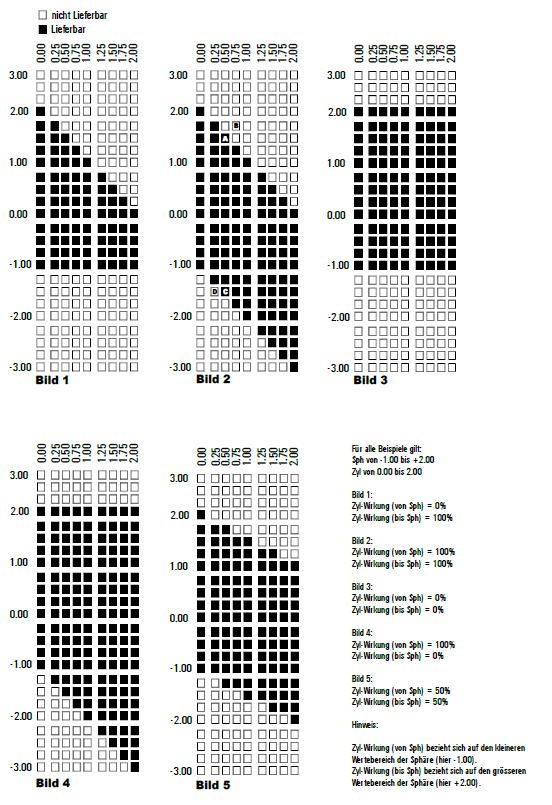Table of Contents
Various definitions
Traffic suitability
Definition of values
0=no information provided
1=no restriction
2=not suitable for traffic
3=not suitable for night driving
5=depends on center thickness and coating
Not suitable for use in traffic With eyeglasses for near and medium distances, the eyecare professional must inform the user that the glasses “are not suitable for use in traffic”. The manufacturer of such eyeglasses must inform the eyecare professional about such restrictions in use.
With eyeglasses, the tint of which does not ensure traffic light recognition in accordance with DIN EN ISO 14880, the manufacturer must inform the eyecare professional about this restriction in use.
Not suitable for night driving As regards eyeglasses, the lenses of which feature light reduction of more than 25%, the eyecare professional must inform the user that these glasses are not suitable for night driving. The manufacturer of eyeglass lenses featuring light reduction of more than 25% (in accordance with DIN EN ISO 14889) must inform the eyecare professional about such restrictions in use.
Cylinder power
The cylinder power fields have been defined in the LensRange.Dat file. They define the effect of the cylinder on the availability of the base lens. In this context, please see the attached graphic examples (page 49)
All five examples have the following delivery range:
Sph -1.00 bis +2.00
Cyl 0.00 bis 2.00
Although the delivery range is identical in all examples, there are differences in the details of the actual delivery ranges (actually available Sph/Cyl ranges: black squares in the delivery range grid). All five possibilities shown in the examples also occur in practice!
An easy way of displaying this is the specification of a percentage factor at which the cylinder affects the strongest principal meridian. The percentage factor is specified for the lowest (“cyl power from” on “strongest principal meridian from”) and highest (“cyl power to” on “strongest principal meridian to) value of the principal meridians. The smallest value is determined by means of a number line. -9.00 is smaller than –2.00, +2.00 is smaller than +5.00).
Therefore, the formula for the resulting principal meridian is: Pr.Mer. = Pr.Mer.=Sph+Cyl*Wirkung%
Example 1: (Cyl power on “st. pr.mer. from”=0% Cyl power on “st.pr.mer. to”=100%). In Fig. 1, the cylinder in the upper range is taken into consideration, and the cylinder in the lower range is not taken into consideration. Here, the typical steps are available in the upper range (plus range) and the lower range (minus range).
Example 2: (Cyl power on “st. pr.mer. from”=100% Cyl power on “st.pr.mer. to”=100%). In both cases, the cylinder effect is 100%. The value “Sph+1.50/Cyl0.50 (marking A) is available, as the resulting strongest principal meridian +2.00 (+1.50+0.50) fits the specified delivery range. The value “Sph+1.75/Cyl0.75” (marking B) is not available. The resulting strongest principal meridian +2.50 (+1.75+0.75) is higher than the Sph value specified as maximum (+2.00). The value “Sph-1.50/Cyl0.50 (marking C) is available, as the resulting strongest principal meridian -1.00 (-1.50+0.50) fits the specified delivery range. The value “Sph-1.50/Cyl0.25” (marking D) is not available. The resulting strongest principal meridian -1.25 (-1.50+0.25) is lower than the Sph value specified as minimum (-1.00).
Example 3: (Cyl power on “st. pr.mer. from”=0% Cyl power on “st.pr.mer. to”=0%). In Fig. 2, the cylinders in the upper and lower ranges are not taken into consideration.
Example 4: (Cyl power on “st. pr.mer. from”=100% Cyl power on “st.pr.mer. to”=0%). In Fig. 4, the cylinder in the upper range is not taken into consideration, while it is taken into consideration in the lower range.
Example 5: (Cyl power on “st. pr.mer. from”=50% Cyl power on “st.pr.mer. from”=50%). In Fig. 5, the cylinders in the upper and lower ranges are taken into consideration with 50%. The value “Sph+1.75/Cyl0.50 is available, as the resulting strongest principal meridian +2.00 (+1.75+(0.50*50%)) fits the specified delivery range. The value “Sph+1.75/Cyl0.75” is not available. The resulting strongest principal meridian +2.125 (+1.75+(0.75*50%)) is higher than the Sph value specified as maximum (+2.00).
Grafik zur Zylinderwirkung

